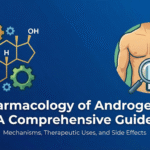Introduction to Structure-Activity Relationships (SAR)
Structure-Activity Relationships (SAR) explore the connection between a compound’s chemical structure and its biological activity. By analyzing how different molecular structures influence biological effects, researchers can predict and optimize the efficacy of organic compounds, playing a crucial role in drug discovery and development.
Principles of SAR
- Molecular Modification: Altering the chemical structure to enhance desired biological activity or reduce side effects.
- Pharmacophore Identification: Determining essential structural features responsible for a compound’s activity.
- Predictive Modeling: Using empirical data to forecast the biological responses of new compounds.
Quantitative Structure-Activity Relationships (QSAR)
QSAR quantitatively correlates chemical structures with biological activities using mathematical models. This approach helps in:
- Predicting Potency and Efficacy: Estimating how structural changes affect activity levels.
- Rational Drug Design: Designing more active and selective drugs based on quantitative data.
- Statistical Analysis: Employing robust statistical methods to avoid false correlations and improve predictive power.
Molecular Descriptors and Their Role in SAR
Molecular descriptors are numerical values representing molecular properties:
- 2D Descriptors: Reflect flat representations of molecules.
- 3D Descriptors: Capture spatial arrangements of molecules.
- Applications:
- Quantitatively correlate structures with potency.
- Prioritize lead compounds based on ligand efficiency.
- Assist in selecting compounds with desirable properties.
Computational Methods in SAR
Computational chemistry enhances SAR studies through:
- Quantum Mechanical Calculations: Estimating bioactivity and electronic properties.
- Molecular Docking and Virtual Screening: Predicting ligand-target interactions.
- Machine Learning and AI: Improving predictive accuracy and handling large datasets.
- Applications:
- Lead identification and optimization.
- In-silico ADME (Absorption, Distribution, Metabolism, Excretion) studies.
- Toxicology predictions.
Case Studies in SAR
- Cancer Therapy: Designing kinase inhibitors based on SAR insights.
- Antiviral Agents: Modifying molecular structures to enhance activity against viruses.
- Antibacterial Compounds: Utilizing SAR to overcome resistance mechanisms.
SAR in Drug Discovery and Development
- Lead Optimization: Refining compounds to improve ADME properties and efficacy.
- Safety Profiling: Reducing clinical trial failures by predicting and mitigating potential toxicities.
- Interdisciplinary Approach: Combining medicinal chemistry with pharmacology and toxicology.
SAR in Pharmacokinetics and Pharmacodynamics
- Predicting Drug Behavior: Understanding how structural changes impact absorption and metabolism.
- Balancing Properties: Enhancing therapeutic effects while minimizing side effects.
- Optimizing Drug Design: Adjusting molecular structures for optimal bioavailability and target engagement.
SAR and Toxicity Prediction
- Identifying Toxicophores: Recognizing structural features associated with toxicity.
- In Silico Modeling: Using computational tools to predict adverse effects.
- Regulatory Implications: Assisting in early-stage decision-making to avoid late-stage failures.
SAR in the Design of Anticancer Agents
- Targeted Therapy: Designing compounds that specifically target cancer-related receptors or genes.
- Enhancing Selectivity: Modifying structures to increase potency against cancer cells while sparing healthy cells.
- Combating Resistance: Developing agents that address drug resistance mechanisms.
SAR in the Development of Antimicrobial Agents
- Overcoming Resistance: Altering structures to bypass microbial defense mechanisms.
- Enhancing Uptake: Designing molecules with improved cellular absorption.
- Broad-Spectrum Activity: Creating agents effective against a wide range of pathogens.
SAR in the Design of CNS-Active Drugs
- Blood-Brain Barrier Permeation: Modifying compounds to improve central nervous system (CNS) accessibility.
- Receptor Selectivity: Targeting specific CNS receptors to reduce adverse effects.
- Optimizing Pharmacokinetics: Ensuring appropriate CNS exposure and activity duration.
SAR in the Field of Natural Products
- Bioactive Compound Identification: Isolating and characterizing active ingredients from natural sources.
- Design Inspiration: Using natural product structures to inspire synthetic analogs.
- Understanding Mechanisms: Studying interactions between natural compounds and biological targets.
SAR in Environmental Chemistry and Toxicology
- Hazard Assessment: Predicting environmental risks based on chemical structure.
- Regulatory Support: Informing policies through mechanistic insights.
- Isosteres in Environmental Fate: Understanding how structural analogs behave in ecological systems.
Emerging Trends in SAR Research
- Big Data Integration: Leveraging large datasets for improved predictive models.
- Artificial Intelligence: Applying deep learning to enhance virtual screening processes.
- Personalized Medicine: Tailoring therapies based on individual SAR profiles.
Challenges and Limitations in SAR Studies
- Data Quality: Ensuring reliable and comprehensive biological activity data.
- Model Transferability: Overcoming limitations in applying models to new compounds.
- Ethical Considerations: Addressing concerns related to experimental design and data usage.
Future Directions in SAR Research
- Computational Advancements: Using enhanced computing power for detailed target interaction modeling.
- Integrated Approaches: Combining QSAR with structure-based receptor interactions for holistic predictions.
- Revolutionizing Drug Design: Moving towards virtual libraries and predictive models to streamline discovery.
Conclusion
Structure-Activity Relationships (SAR) are pivotal for understanding how molecular structures influence biological activity. By integrating computational methods, predictive modeling, and interdisciplinary research, SAR studies will continue to drive innovations in drug discovery, environmental safety, and therapeutic applications, leading to more effective and safer drugs in the future.
📚 AI Pharma Quiz Generator
🎉 Quiz Results
Medical Disclaimer
The medical information on this post is for general educational purposes only and is provided by Pharmacology Mentor. While we strive to keep content current and accurate, Pharmacology Mentor makes no representations or warranties, express or implied, regarding the completeness, accuracy, reliability, suitability, or availability of the post, the website, or any information, products, services, or related graphics for any purpose. This content is not a substitute for professional medical advice, diagnosis, or treatment; always seek the advice of your physician or other qualified health provider with any questions you may have regarding a medical condition and never disregard or delay seeking professional advice because of something you have read here. Reliance on any information provided is solely at your own risk.









